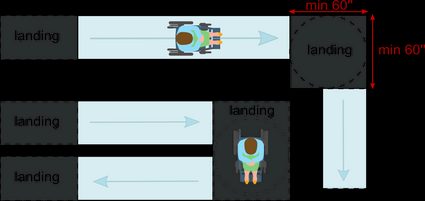ADA Standards Ramp Calculator
ADA ramp slopes
The 2010 ADA Standards (Americans with Disabilities Act) set out some minimum requirements for new public facilities. As well as including many different accessibility standards, it contains guidelines for ramp construction. In this paragraph, we'll take a closer look at ADA ramp slopes.
According to the ADA standards, the least steep slope shall be used for any ramp. Apart from that information, what exactly does the guideline say?
- is the maximum slope of a ramp for new constructions

- is the comfortable slope

- is the minimum slope - below that value, it's not considered a ramp (thus, e.g., handrails are not needed)

In each case, the maximum rise allowed is (). These three ADA ramp slope values are preset in our ramp calculator.
If existing sites, buildings, and facilities have space limitations, steeper ADA ramp slopes may be permitted. However, stricter restrictions on the maximum rise apply:
|
Slope |
Maximum rise |
|
|---|---|---|
|
inches |
millimeters |
|
|
to |
inches |
|
|
to |
inches |
|
Remember that the ADA prohibits slopes steeper than 1:8.
Other ADA ramp requirements
When constructing a ramp, be it for your home, public space, or temporary use, you need to think about a few things other than a ramp slope and rise:
1. Clear width
The minimum clear width of a ramp is (). Don't forget to take into account the mounting of handrails when designing a ramp.
2. Landings
Every ramp should have level landings at the top and bottom of each section - especially if your ramp has multiple sections (turns). The following landing features are essential:
- The minimum landing length is (), and the landing's width should be at least as wide as the ramp's run.

- You need to provide enough space for maneuvers: if the ramp construction changes direction (a 90-degree turn), then the minimum landing size is :

Don't forget to add even more space for switchback ramps.
3. Handrails
Every time a ramp has:
-
a rise greater than () or
-
a run greater than (),
Then the handrails are needed on both sides to comply with ADA standards. You will find more details in paragraph 4.8.5 of the
4. Other important factors are:
- The cross slope (camber) of the ramps cannot exceed ;
- The ramp should be made out of appropriate material to prevent sliding and slipping;
- Edge protection and handrail extensions; and
- Taking into account weather conditions if it's an outdoor ramp (proper drainage).
Use Ramp Calculator Here:


